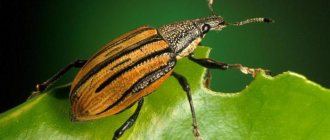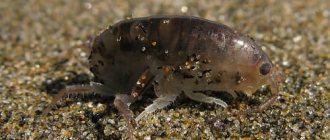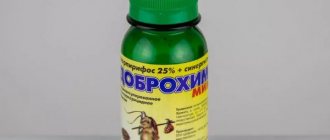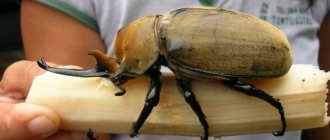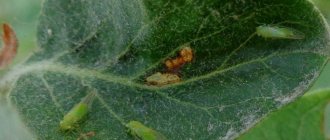Most insect bites cause minor discomfort, but some encounters can be dangerous, especially if your child has allergies. The shape of the bite depends on the insect.
In this article we will give examples of bites and also tell you how to treat them.
Attention! The article contains photographs.
Types of blood-sucking and stinging insects
Many insects bite and sting, but few do it intentionally. Most bites are relatively harmless, leaving only an itchy patch of skin.
But some insects can be carriers of serious diseases, and then the bites pose a danger to humans.
Insects that bite intentionally:
- mites;
- bedbugs;
- fleas;
- lice;
- midges;
- mosquitoes.
Many large insects will not specifically seek out prey to sting, but will bite if they feel threatened. Usually the sting of a bee or ant contains poison. When it is injected into the skin, a sensation of itching and pain occurs.
Stinging insects:
- bees;
- hornets;
- wasps;
- red forest ants.
Prevention
Regardless of the foresight of a particular person, a situation may still arise that he will not be able to avoid an insect bite. But at the same time, one should not neglect the rules of prevention, compliance with which will help to minimize the number of unpleasant cases.
If you don't want bees or wasps to bite you at the first opportunity, then you need to remember the following:
Don't get too close to apiaries without wearing appropriate clothing. If while walking through the forest you suddenly find a wasp nest , do not make sudden movements, but try to slowly move away from it.
If you are planning an outdoor trip, do not use perfumes or deodorants that have sweet or floral scents. You should also be selective about clothes, which should not have bright colors.
If you do come across flying bees or wasps, do not make sudden movements when you want to smack the insect away, as this will be a signal to attack.
What Causes a Sting Reaction?
The venom introduced into the body through a bite engages the body's immune system. Often the immediate reaction includes redness and swelling of the affected area, followed later by itching and soreness.
If a child is very sensitive to insect venom, bites can cause anaphylactic shock: constriction of the throat and difficulty breathing.
Sand fly or sand flea?
Do not confuse the sand fly with the sand flea. The latter is not found in Thailand. The sand flea is similar to the common flea that a left-hander shod. She moves by jumping and has no wings. Habitats: India, Africa, Central and South America. This insect is even called the Brazilian ground flea. It is dangerous because when a fertilized female bites, it bites under the skin and remains there until the eggs mature. Of course, there are fleas in Thailand, but not the ones called sand flea.
Sand fleas are also called crustaceans of the genus Emerita. Some of their names include sea cicada, mole crab and sand crab. In Thai it's "chak-kachan-tale". In Phuket, such crustaceans are collected, fried directly with the shell and eaten. You can try sea cicadas at Indy Market, Chilwa Market and Thalang Street Sunday Market. Quite a tasty snack.
On the beaches of Thailand, only sand flies can bite. In Thai they are called "rin nam-khem", which translates to "sea midge" or "salt water midge". In Russian, sand flies are called true midges; they belong to the genus Culicoides.
What are the symptoms of a dangerous bite?
Some people do not notice the insect and may not realize they have been bitten until one or more of the following symptoms appear:
- swelling;
- redness or rash;
- pain in the affected area or muscles;
- itching;
- a feeling of heat or numbness at or around the bite site;
- tingling in the affected area.
Symptoms of a severe reaction requiring immediate medical attention include:
- temperature;
- labored breathing;
- nausea or vomiting;
- muscle spasm;
- cardiopalmus;
- swelling of the lips and throat
- confusion or loss of consciousness.
If flu-like symptoms do not go away within a few days after the bite, you should contact an infectious disease specialist for additional tests.
Meningococcal infection and meningococcal sepsis are a deadly disease.
It is manifested by a very high temperature, a severe general condition of the child, which worsens every hour, vomiting, and impaired consciousness. Against the background of a high temperature, the child develops a rash (there may be only a few elements), which does not disappear with pressure. If you see such a picture in a child, you should immediately call an ambulance.
In addition to these diseases, a rash on the body occurs with a herpetic infection - in the form of blisters, with infectious mononucleosis - with the prescription of antibiotics from the amoxicillin group, with pseudotuberculosis and yersiniosis - in the form of “socks” and “gloves” and many others.
As a rule, the rash associated with various infections is quite typical and additional laboratory examination is not required to make a diagnosis.
In almost all infectious diseases, in addition to the rash, there is a high (or not so high) temperature, general malaise, loss of appetite, and chills. Your head, throat, or stomach may hurt. Have a runny nose, or cough, or diarrhea.
In addition to infections, the rash occurs with diseases of the blood or blood vessels. In these cases, the appearance of a rash is provoked by injuries, sometimes very minor. The rash looks like large or small hemorrhages (bruises) and requires additional examination to make an accurate diagnosis.
In conclusion, I would like to once again draw the attention of parents to the fact that they should not try to understand on their own what kind of rash the child has developed. Call the doctor
And most importantly, do not paint on this rash with fucorcin, iodine or brilliant green. Once you have satisfied your drawing needs, no doctor will ever guess what was really there.
Treatment of insect bites
- With a mild reaction
Most bites can be treated at home, especially if the reaction is mild.
Remove the stinger if it is stuck in the skin, wash the affected area and apply an ice pack to reduce pain and swelling.
Topical anti-itch creams, oral pain relievers, and antihistamines are used to combat unpleasant symptoms. Sometimes doctors recommend applying a thin layer of paste made from baking soda and water to relieve itching.
- For severe reaction
If you have symptoms of a severe reaction, you should immediately contact an ambulance.
First aid instructions while waiting for doctors to arrive include unbuttoning clothing, lying on your side, and performing artificial respiration if necessary.
When there is nothing at hand
If there is no chance of getting to the pharmacy, kitchen or garden bed, and your hand treacherously reaches out to comb everything that itches, try to deceive your receptors.
Click on the bite
Press firmly on the bite site, it will become a little easier. The effect is temporary, you will have to repeat it, but it is better than scratching yourself until you bleed: the bite will heal faster than scratches, and you will not introduce an infection into the wound.
Pat the bite
Instead of scratching, smack the bite area, even hard. This is similar to scratching, only less traumatic - you trick the brain, causing mild pain.
Oh, summer is red! I would love you
If only it weren't for the heat, the dust, the mosquitoes, and the flies.
A.S. Pushkin
Summer is not only the time of vacations, warm sun, gentle sea, but also the time of annoying mosquitoes that squeak over the ear, do not allow you to sleep peacefully, bite, and then the bite site is terribly itchy and itchy.
Only female mosquitoes bite. Male gnats do not suck blood - they feed on plant matter and nectar. But females bite both people and animals. Such food is necessary for females to bear offspring. Just one drop of blood gives life to thousands of mosquito eggs.
Moreover, some people attract mosquitoes more, and some people do not bite at all. Why does such injustice happen and who gets bitten by mosquitoes?
1. Mosquitoes identify their prey by the heat that our body produces, as well as by the carbon dioxide that is released during respiration. Therefore, first of all, mosquitoes bite overweight people and people who breathe frequently, move a lot and sweat a lot
. Therefore, it is better to sit quietly on a bench than to play outdoor games. This way you have a better chance of not getting bitten.
2. There is a saying that a mosquito loves bad blood.
. And when a person is sick, a lot of heat moves to the part of the body that is sick. The mosquito senses this and therefore, first of all, flies to warm areas of the body to drink blood. If a person is healthy, then, guided by the same instincts, the mosquito selects warm areas on the human body - this is primarily the skin, next to which veins and arteries are located. When you are bitten by a mosquito, and you slap the site of the bite and possibly kill the mosquito, you thereby heat up your blood even more, especially in the place where you were just bitten. And other mosquitoes that fly nearby will definitely feel it.
3. Mosquitoes also bite people with thin skin, including children.
.
4. There is an opinion that mosquitoes bite people with blood group III
. There is no explanation for this, but numerous surveys have shown that this is indeed the case.
5. The most interesting thing is that mosquitoes practically do not bite vegetarians and especially raw foodists. It is possible that vegetarians and raw foodists have very pure blood, there are no unnecessary odors, and therefore mosquitoes rarely bite such people, if not avoid them at all. This means that if you want not to be bitten by mosquitoes, then you need to become vegetarians, raw foodists.
How to protect yourself and your child from mosquito bites?
In any store you can find chemical methods to combat mosquitoes (creams, fumigators, repellents, plates, spirals...), but many people prefer environmental means.
So, mosquitoes try to stay away from walnut leaves and do not tolerate the smell of basil and incense. To one degree or another, insects are repelled by wormwood, mint, cloves, lavender, rose geranium, serviceberry leaves, lemon, tangerine, orange fruits, parsnip seeds, Siberian hogweed, fir and Siberian cedar needles, thuja leaves, common ivy, and horse chestnut.
There are also mosquito repellent bracelets and ultrasonic repellent devices. Scientists have also come up with special anti-encephalitis jackets and suits, even for children. These clothes consist of two layers of fabric that move with the slightest movement. And if at this moment the mosquito sticks its proboscis through your clothing, the layers of fabric shift, the mosquito’s proboscis breaks and it will no longer bother you.
We must also not forget about mask nets on windows and vents, as well as special nets for cribs and strollers
What to do if mosquitoes still bite you? How to relieve itching from mosquito bites in simple and effective ways?
The most important thing: under no circumstances should you scratch the site of the bite, this will only increase the itching!
One of the simplest remedies is saliva; it can be used to lubricate the bite site when there is nothing else at hand.
Citrus juice (lemon, orange, lime) helps relieve itching.
To quickly relieve itching, you can use onion juice and chopped garlic.
Midges
Blood-sucking creatures are black in color, up to 3 mm in size. They annoy people at the end of May, beginning of June - when the pine tree blooms. They live en masse in the wild and do not penetrate indoors. They bite during daylight hours and hide in the evening. You can get hurt in a forest, a city park, near a house where there are trees or vegetation, or in a country house.
An insect bite on human skin has characteristic symptoms:
- redness up to 0.5 cm in diameter, a dark dot in the center - dried blood;
- painful sensations;
- severe itching appears after a while;
- the bite on the human body disappears within 2 weeks.
A midge attack rarely ends in a severe allergic reaction; folk remedies and pharmaceutical preparations based on natural ingredients are used for treatment. A photo of midge bites on the skin is presented below.
Bees.
A bee dies after stinging a person, as it leaves its stomach and digestive tract along with the sting. Therefore, their bites are easy to recognize. Remove the stinger from your body immediately to prevent the venom from entering your bloodstream. A bee sting is the second leading cause of anaphylaxis, so if you experience shortness of breath, a drop in blood pressure, or trouble breathing, call an ambulance.
Causes of the rash
A rash that looks like mosquito bites can occur for the following reasons:
- Prickly heat.
- Hives.
- Allergic reaction.
- Infection.
- Insect bites.
A thorough examination of the problem area will help you understand what exactly led to the rash. You need to pay attention to where exactly the pimples are located - on the face, arm, stomach or leg. The presence of accompanying symptoms, for example, irritation and itching, is also taken into account.
In the summer, people rarely have questions about why pimples form on their skin. Everyone is accustomed to blaming various insects for this, which tend to attack a person and feed on his blood.
A feeling of anxiety appears when pimples similar to mosquito bites are found in winter. In this case, the rash can be attributed to a disease developing inside the body.
Hives
Children and adults may show signs of urticaria in the form of pimples that resemble marks after bites of blood-sucking insects.
Hives are recognized by pale pink blisters that rise slightly above the surface of the skin.
They resemble peculiar burns that occur after contact with nettles. This rash will be very itchy.
An increase in the severity of urticaria symptoms occurs after a person interacts with any irritant. This may include pet hair, pollen, medications, perfumes and cosmetics, solar radiation, and even low temperatures. It is very important to identify what exactly causes discomfort and immediately stop contacting it.
Food allergies
Strange spots that closely resemble ordinary mosquito bites appear on different parts of the body after a person eats a product that provokes an allergic reaction.
READ ALSO: How to treat boils - photos, treatment methods
This usually happens after eating seafood, citrus fruits, milk and honey. Chocolate products and natural honey are often the culprits of illness.
This disorder is recognized by its characteristic symptoms:
- The appearance on the skin of small tubercles and spots that differ from each other in size. Their location is chaotic.
- The formation of such elements some time after consuming a certain product or medicine.
- Rapid disappearance of the rash after taking a drug with an antihistamine effect.
- Instant increase in the size of pimples and their rapid growth.
In case of allergies, it is necessary to immediately cleanse the body of toxic substances that cause deterioration in health. Sorbents help cope with this task. Also, do not forget about antihistamines.
More recently, measles was a relatively rare disease. But recently, outbreaks of the disease have become noticeably more frequent.
This is because a minimal percentage of people today agree to be vaccinated against measles. The disease makes itself felt with a sudden increase in temperature, redness of the throat and dry cough.
Around the 5th day of infection, small papules appear. They are located on the face and gradually spread to different parts of the body.
If left untreated, the likelihood of infection in the digestive, nervous and respiratory systems increases.
Rubella
Another viral infection that is usually diagnosed in young children. It causes a rash that is somewhat reminiscent of insect bites.
Gradually, the pimples turn into noticeable spots. Along with this, other symptoms of the disease arise:
- Enlarged lymph nodes in the back of the head and neck.
- Increased body temperature.
- Headache.
This disease poses the greatest threat to pregnant women. The pathological process can interfere with the development of the fetus, which is fraught with various disturbances in the functioning of the organs of vision, blood vessels and heart.
